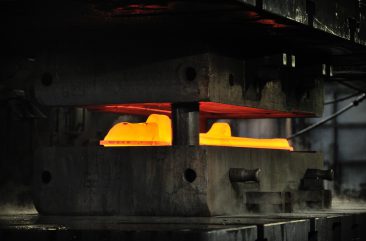When the ingot forging reaches a certain forging ratio, the dendritic grains of the as-cast structure is broken and deformed, and elongated along the main deformation direction.
At the same time, the morphology of carbides, non-metallic inclusions and other excess phases aggregated at grain boundaries also change. Among them, carbides, brittle silicates and oxides have poor plasticity, are not deformed or slightly deformed after pressure processing, and are easily broken. Or chain-like distribution; plastic silicates and sulfides have good plasticity, deform together with the grains, and are elongated along the main deformation direction, in the shape of strips or spindles.
This distribution of excess phase at most grain boundaries will not change after grain recrystallization, so that the metal structure has a certain directionality, which is usually called “fibrous structure”, and its macroscopic traces are “streamlines”. When the steel ingot is only subjected to elongation and deformation, the fibrous structure will appear when the forging ratio reaches 2~3; if upsetting is performed first and then elongated, the fibrous structure can only be formed when the forging ratio reaches 4~5, and the larger the forging ratio is. , the fiber direction is more obvious. The basic conditions for pore defects in forged steel ingots are: the surface of the pores is not oxidized, there is no non-metallic inclusions (slag) in the pores, the pores are in a state of three-dimensional compressive stress during high-temperature forging deformation, and a sufficient forging ratio is required.
The effect of the forging ratio on the metal structure can be evaluated by measuring the density of the metal, low magnification inspection and ultrasonic detection to evaluate the forging compaction effect; high magnification metallographic inspection can be used to evaluate the grain size and the fragmentation and distribution of excess intergranular phases.
The 40Cr steel ingots were elongated and deformed, and the specimens with different cross-sectional dimensions were obtained according to the requirements of different forging ratios, and the density of the core samples of each specimen was measured respectively. The test results show that when the forging ratio is 2, the density of the sample is close to the maximum value.
When the forging ratio is greater than 2.5, the density of the sample basically does not increase. The test results of a large number of forging blanks and shaft forgings with horizontal low magnification test pieces show that: when the forging ratio of drawing length reaches more than 2.0, when the section size of the forging blank and the forging equipment and forging process are reasonably matched, the general looseness and central looseness can be When it reaches the level below 0.5 to 1.0, it becomes a dense “forged” structure.
The complete crushing of dendrites, especially for large-section alloy steel forgings, requires a larger or even greater forging ratio than 5.0. At this time, a large number of dendrites still exist.

